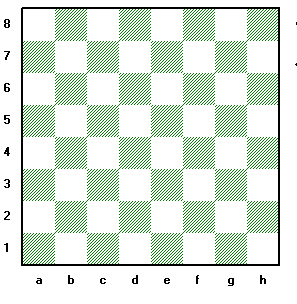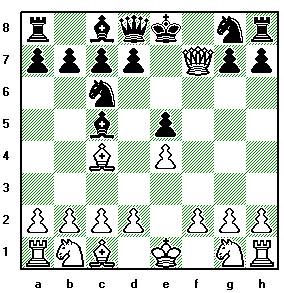|
Castle Chess Club Chess Notation 1 - The board The chess board is divided up into 64 squares, 32 white and 32 ‘black’ (though the black ones can be other colours!). The board should be turned so that your have a black square in the corner to your left, and a right square in the corner to your right - as in this figure:
Many boards, including those used at Castles Chess Club, have letters and numbers around the edge of the board. These make it easy to put the board the right way round - just make sure that the letters a to h are facing you when you sit down to play (though for black the order is from h to a). The chess board can be considered to consist of 8 columns. The left most column being labelled ‘a’, the second ‘b’, and so on until the last, labelled ‘h’. In chess the columns are normally called files. For instance the queens start on the d file. Note that lower case are used for the file - b not B - capital letters are only used for the pieces. Similarly the board can be split into 8 rows. The row where white’s King starts is row 1, where white’s pawns start is row 2, and so on until you reach the row where black’s pawns start, row 7 and the row where black’s pieces start, row 8. In chess the rows are normally called ranks. Using the letter standing for the file (column) and the number for the rank (row) every square on the chess board can be uniquely labelled, as the following figure illustrates: Note that the letter is given before the number. Thus the white rooks start on a1 and h1, and the black rooks start on a8 and h8.
Chess Notation 2 - Recording a Game Using the named squares of the chess board we can record moves, this is useful both to record your own game and for looking at other peoples games, from those of friends to world champions’. The simplest form would be to give the starting and ending squares. This is what is normally done for pawn moves. For other pieces a capital letter is also used to name the piece being moved: K for King; Q for Queen; R for Rook; B for Bishop and N for Knight. Moves are numbered in pairs, starting from 1 for white and black’s first move. So Scholar’s Mate is recorded as follows: 1. e2 - e4 e7 - e5 2. Bf1 - c4 Bf8 - c5 The position is now:
3. Qd1 - h5 Nb8 - c6 4. Qh5 x f7++ (Checkmate)
Note that often the ‘-‘ for normal moves is not included (so white’s first move would be just e2e4), but x is always used for captures; + stands for check and ++ for checkmate, O-O represents casting on the king side and O-O-O castling on the queen side (each O representing an empty square between the king and the rook). A variant on this ‘full’ form of ‘algebraic notation’ is a shortened form where the minimum amount of information required to work out the moves is given. In this case the starting square is not normally given, except where two identical pieces can move to the same square in which case the rank or file is given to avoid ambiguity. |
Back to Castles home page


